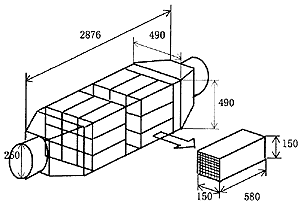
Fig. 1 Contour of SCR reactor
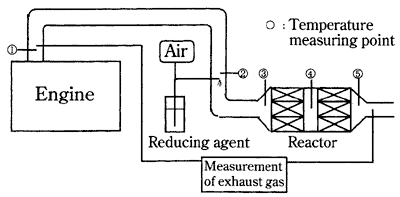
Fig. 2 System diagram of SCR system
The effect of the SCR system on the harmful exhaust emissions such as N2O was examined by measuring the exhaust gas concentration when the reducing agent was poured in the SCR system at the outlet of the SCR system, and when no reducing agent was poured.
3. Test data and consideration
3.1 Effect of difference in fuel property on the content of harmful exhaust emissions such as N2O.
The diesel engine was run at the 50% and 75% loads of the maximum continuous output with a propellar law using MDF (A) and two kinds of MFO (C1, C2) different in sulfur content and nitrogen content in the fuel, and the effect of the fuel property on the exhaust gas concentration was examined by measuring the exhaust gas concentration. For MDF (A), only the data in 50% load condition was collected. Further, the seasonal change in the exhaust gas concentration was examined by comparing the exhaust gas concentration in February, April and July. The exhaust gas concentration was compared after it was converted into the value under 13% O2 concentration.
Table 4 Composition of exhaust gas, and measuring instruments
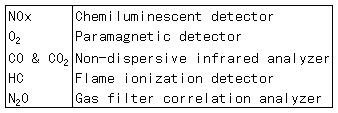
3.1.1 NOx
Fig. 3 shows the NOx concentration to each fuel. Fig. 4 shows the change in NOx concentration relative to the measuring time in the fuel A and the fuel C1.
These results show that MDF (A) presents higher NOx concentration than that of MFO. Fig. 5 shows the comparison of the in-cylinder pressure, the injection pressure, the injection period, the in-cylinder temperature and the heat release rate for each fuel at 50% load, and it is shown that MDF is earlier in the ignition time than MFO, and more in the initial combustion than MFO, and highest in the in-cylinder pressure. NOx includes the fuel NOx to be produced from the nitrogen in the fuel and the thermal NOx to be produced in the reaction of nitrogen in air in the condition of high temperature and high pressure, and in the diesel engine, the ratio of the latter is larger. Thus, it is believed in this test that more thermal NOx was produced in MDF (A) in which the in-cylinder pressure is highest than in MFO, and as a result, the NOx concentration was highest. The in-cylinder pressure waveform was almost same between the fuel C1 and the fuel C2, but the in-cylinder temperature was higher in the fuel C1, and it is thus believed that more thermal NOx was produced than in the fuel C2. As a result, it is believed that, in this test, the fuel C1 was higher in NOx concentration than the fuel C2.
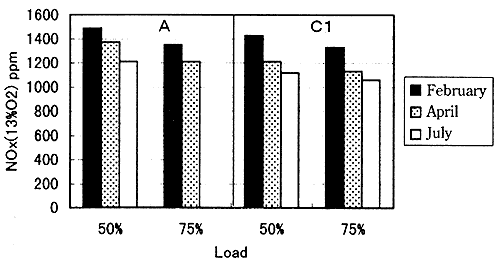
Fig. 3 Effect of difference in fuel property on NOx
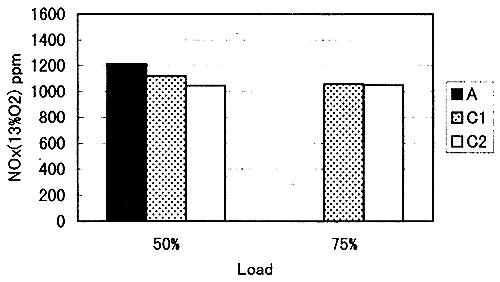
Fig. 4 Change in NO concentration to measurement time
BACK CONTENTS NEXT